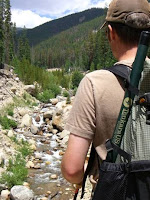A while back I got in touch with Jason Klass of Tenkara Talk. As can be guessed by the name of his site (and previous projects like Gear talk with Jason Klass, he’s an outdoor aficionado with a passion for fishing. He kindly agreed to put together an article about Tenkara’s line of backpacking fly fishing rods. I’ll let him take it from here:
Tenkara 101 for Backpackers
by Jason Klass
Have you always wanted to bring fishing equipment on your backpacking trips but thought it might be too heavy, bulky, or too much of a hassle? Do you already fish on the trail but want to lighten up your gear? If you answered yes to either of these questions, then Tenkara fishing might be just what you’re looking for.
Tenkara is an ancient method of fishing from Japan which uses only a rod and a line (that’s right, no reel!). Traditionally, the rods were made of bamboo, but today’s modern Tenkara rods are made of much lighter graphite and fiberglass. Tenkara rods are fairly long by Western standards (usually 11 – 15 ft.). Since the line is fixed to the end of the rod, the longer rod length gives the angler more reach. Lines are typically the same length of the rod or longer.
Tenkara rods are telescopic and this is probably the greatest advantage for the backpacker. For one, all the segments collapse in on each other and seal with an end plug. The rod itself essentially becomes its own protective case so there’s no need carry a bulky, heavy case. This on only saves weight, but when closed, the rods are extremely compact and will easily fit in the side pocket of your pack.
rods are telescopic and this is probably the greatest advantage for the backpacker. For one, all the segments collapse in on each other and seal with an end plug. The rod itself essentially becomes its own protective case so there’s no need carry a bulky, heavy case. This on only saves weight, but when closed, the rods are extremely compact and will easily fit in the side pocket of your pack.
I like to take advantage of fishing opportunities along the trail on my way to camp and Tenkara rods give the backpacker another advantage: quick deployment. You can literally grab the rod from your side pocket, extend it, and be fishing in a minute or two without having to worry about rod sections lining up, the reel, the leader, etc. I’ve lost many fishing opportunities because it took me too long to get my Western fly rod set up.
By now you might be wondering how you would catch that trout in the middle of the lake that’s 70 ft. away if you’ve only got an 11 ft. rod with an 11 ft. line. The answer is simple. You can’t. Well, actually you could if you waded out there. It’s important to keep in mind that Tenkara fishing is not meant for distance. It’s meant for small streams and to be a simple technique that connects you more to the stream and the fish, rather than your equipment. If you backpack near streams and small ponds or lakes, Tenkara is perfect. If you need to cast 80 ft and fish in 20 ft. of water, not so much.
You might also be wondering how you land a fish if there is no reel. If you think about what Tenkara is designed for (small streams and relatively smaller fish), then the question becomes moot. I fished many years in small streams on backpacking trips with a Western fly rod and never once actually used a reel to bring in a fish. I just tilted the rod back behind me until I could reach the line, and pulled the fish in that way. And that’s exactly how you do it in Tenkara. Why carry a reel if you’re not going to use it?
Another advantage of Tenkara fishing is that the simplicity allows you to carry less gear. This is literally all you need: A Tenkara rod, a line, some tippet material, nippers, hemostats, a small fly box with flies, and maybe some fly floatant. You don’t need to carry a 20 lb. fishing vest on your backpacking trip. Check out this video on what I carry in my ultralight fishing kit on my backpacking trips:
I could go into a lot more technical detail about why Tenkara just makes sense for backpackers, but there is plenty of info on the web for you to research it and come to your own conclusion. One last point though. Tenkara fishing is not only practical and effective, it’s also extremely fun and incredibly easy to learn. I used to be a fly casting instructor and watched countless customers suffer through months or agonizing practice and frustration just to learn basic casts. With Tenkara, I taught my wife (who had never fished a day in her life) to cast in minutes and on her first try, she caught 3 beautiful cutthroat trout. Since it’s so easy to learn, Tenkara is also great for kids.
So, whether you’re an experience backcountry angler or just thinking about getting started, do a little research on Tenkara and you might find it’s just the right fit for you.
Here are some resources to get you started:
Tenkara USA
Tenkara Bum
Tenkara on the Fly
Thanks Jason! Don’t forget to check out both of Jason’s site:
 The Outdoor Adventure Giving you tips, tricks & recommendations to help make adventuring in the Outdoors fun, safe & exciting for you and your kids.
The Outdoor Adventure Giving you tips, tricks & recommendations to help make adventuring in the Outdoors fun, safe & exciting for you and your kids.








